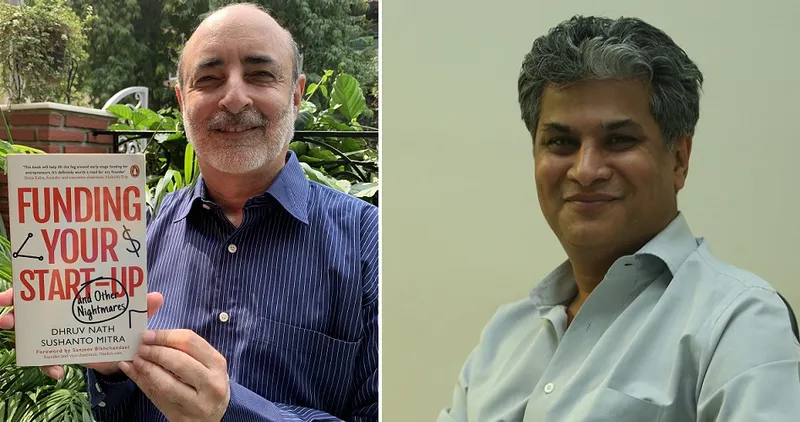From idea to investment: entrepreneurship tips from Dhruv Nath and Sushanto Mitra, Authors of ‘Funding your Startup’
Authors of this compelling book on startups share valuable insights on the rise of angel investing in India, resilience strategies during the pandemic, and the journey from launch to growth.
Dhruv Nath and Sushanto Mitra are the co-authors of Funding your Startup, a guide to entrepreneurs on startup journeys and fundraising (see my book review here).
The must-read book develops a business framework and investment foundations, which are illustrated in the stories of seven startups who applied for early-stage funding, and five startups who applied for later-stage funding. The analysis covers successes and failures, both of which are instructive for aspiring founders.
Dhruv Nath is a professor at the Management Development Institute, Gurugram. An IIT Delhi graduate, he is also an angel investor and a Director with Lead Angels. He was earlier SVP at NIIT. Sushanto Mitra is the Founder of Lead Angels. He was earlier the founding CEO of Society for Innovation and Entrepreneurship (SINE), IIT Bombay, and the Director of Hyderabad Angels.
In this chat with YourStory, Dhruv and Sushanto talk about the journey of an entrepreneur, resilience in the pandemic era, and ecosystem support for entrepreneurship.
Edited excerpts from the interview:
YourStory [YS]: What are the typical challenges entrepreneurs face as they scale up their company from startup to growth stage? How can these challenges be addressed?
Dhruv and Sushanto [D&S]: There are several challenges, but we’ll mention two of the main ones. First of all, when you create a startup, you are in experimentation mode, and you will need to pivot your business model, perhaps repeatedly. That, of course, needs one set of skills. However, once you start scaling up, your business model is hopefully settled, but you are now dealing with far larger numbers.
Tasks that you perhaps did on your own earlier, will need to be delegated – perhaps a couple of levels lower. In other words, you will need to figure out the art of delegation while still maintaining growth, as well as quality. In some sense, you are moving from a do-it-yourself mode to a get-someone-to-do-it mode. And that’s not an easy transition, especially for hands-on founders.
As a corollary, managing people – including those at remote locations – becomes key. And by the way, that is the subject for a possible sequel to our current book.
YS: How should innovators strike that delicate balance between ‘stick to your vision’ and ‘adapt to a changed world?’
D&S: In our opinion, there is no conflict between the two. Vision is long term – something that the founders aspire to. Within this, you would need to pivot several times based on the environment, competition, and recently, even COVID-19. But, it’s all within your overall vision.
A great example is an interesting company called MyCuteOffice, in which Lead Angels has invested. The vision of the founder was to provide affordable office space to companies. When it started, it looked at partially unused office spaces and provided these on rent.
However, over time, it shifted to complete office spaces, which it managed as co-working spaces. In other words, the founders pivoted the business model within the overall vision of providing affordable office space.
YS: Is there such a thing as an ‘ideal age’ for an entrepreneur, or can the startup bug strike you at any time?
D&S: The ideal age is when you have the passion to do something. And if you have the passion, energy flows from it quite naturally. We have seen founders creating successful businesses in their sixties.
A classic example is Rohtash Mal, who created EM3 Agri Services when he was past 60. And, of course, who can forget the 77-year-old Ashok Soota, with his highly successful IPO of Happiest Minds just recently.
The flip side, of course, is that investors usually prefer younger founders. Not too young, mind you – college kids and those who are fresh out of college are perhaps not the ones likely to get funding. Some level of maturity is preferred.
YS: It’s one thing to fail with a product, and a bigger dimension to fail with a company. How should founders regroup in these two situations?
D&S: Both are learning experiences. Failing with a product or service would need the founder to pivot the business model – as seen in the example of MyCuteOffice earlier. And this will happen several times during the life of a venture. The founder needs to prepare for such a situation because it will happen. The important thing is to keep looking out for signals that the product, service, or business model needs to change and to take action whenever that happens.
Clearly, the entire company failing is a far bigger issue. This could happen for several reasons, the most common being that the company continues to burn cash and is unable to get funding to replenish it. Or, it has no entry barrier and is simply unable to compete with the bigger fish in the pond. Usually, this happens despite pivoting.
However, founders need to remember that this is not necessarily a negative situation. As long as they learn from this experience, this learning can be used in the next venture. In fact, several founders have actually created success stories after a failed startup.
YS: How was your book received? What were some of the unusual responses and reactions you got?
D&S: Fortunately, it has been received very well. The best part is that the founders of several successful startups that have already raised funding have got back to us and told us that they found the book extremely useful.
The one thing everyone seems to have appreciated is our PERSISTENT framework for creating successful and investible startups. Finally, the founders have a simple framework, within which they can evaluate their startup.
And, since everyone has appreciated it, we’ll just summarise it here – P (Problem: Are you solving a problem for your customer), E (Earnings model), R (Risks in the business), S (Size of the market), I (Innovation), S (Scalability), T (Team, starting with the founders), E (Entry barrier), N (Niche – when the market is crowded, identify a non-crowded niche), and finally, T (Traction: The final proof that all the above is working).
YS: What is your current field of research in entrepreneurship?
D&S: One of us (Dhruv Nath) is a professor, and he has been doing some interesting research work in the area of angel investing – specifically on the subject of emerging angel investors. This is a fascinating subject, which looks at the evolution of angel investors from the days of the super-rich HNIs, who would not blink when investing crores, to the emergence of the Aam Aadmi Angel, who invests as little as Rs 5 lakh in a startup.
It is the emergence of several thousand such Aam Aadmi Angels that has truly revolutionised the world of startup funding. Two research papers on the subject have been presented at international conferences in Tokyo and Stockholm.
YS: How big a role do academics play in entrepreneurship? Can entrepreneurship really be formally taught?
D&S: We believe entrepreneurship must be learned, not taught. You cannot have a classroom environment where professors give you theories and rule after rule after rule. At Lead Angels, we realised this long ago, and therefore, we started the “Lead Angels Academy,” where we nurture and mentor potential founders.
The learning is entirely case-based – and that too, based on startups that are still young rather than the big boys such as Oyo Rooms and Byju’s. The most important component of this is the live weekly mentoring sessions, where each participant has a chance to get his startup analysed.
YS: What are three ways in which startups can rebound from the COVID crisis?
D&S: Many startups have been literally pummelled out of shape during the COVID crisis. In fact, when even giants such as Indigo, PVR, Taj Hotels, and are in dire straits, what can poor startups do?
Perhaps surprisingly, there is a lot that they can do. In fact, COVID has truly separated the men from the boys – those who say, “Mar gaya,” and wait for God to grant them a vaccine, versus those who are willing to fight it out.
Take a look at IRIL Fresh, an interesting company which picked up natural, pesticide-free fruit and vegetables from Himachal, and sold them to outlets in Delhi and Gurugram. Unfortunately, COVID blocked its entire supply chain from Himachal. So did the founders say, “Mar gaya?” No way.
They realised that even local supply chains within Delhi-NCR had been hit due to the crisis, and even the usual vegetables – not the fertiliser-free ones – were finding it tough to reach retailers. So they decided to pick up these vegetables directly from Delhi and Gurugram-based farmers and supply them to local retailers.
The result? They survived the lockdown, and, in fact, increased their revenue during the crisis. Now that the lockdown is over and their supply chain from Himachal has been restored, they are back to their original business – namely supplying natural products from Himachal.
Of course, there are many, many mundane things that you can do to last through the crisis. You can cut costs – but, of course, you already knew that. For instance, reduce salaries where possible. But don’t release your top performers – you will not find it easy to get them back!
Move to lower-cost offices – in fact, move to smaller offices since a lot of the work would be work from home anyway. Renegotiate rents with your landlords where you can. In other words, cut costs, cut costs, and cut costs!
And if you cannot get business, do you simply sit back and do nothing? Of course not. Look at Villotale – an interesting startup that makes available village homestays – along with the experience of village and farm life. Since no one wants to travel right now, revenue is currently at zero.
However, the founders are spending their time tying up with more and more village homestays, so that they are in a position to offer lots of choice to their travellers whenever COVID decides to ease off. In other words, they do not have revenues right now, but they are using the slack time to focus on building their database of homestays.
To summarise, every startup will have its ways of surviving through the current crisis and preparing for the morning after. But a lot depends on the fighting abilities of the founders.
YS: Conversely, what are some examples of startups you have seen which have actually thrived during the crisis?
D&S: The biggest success stories have been those that have been positively impacted by the COVID pandemic. The obvious ones are , , , , and , since home deliveries have shot up. These, of course, are well-known examples.
But then you have the lesser-known guys such as — a startup in the area of extra-curricular learning for young children — which has seen its revenue boom. Of course, the fact that they pivoted from a hybrid model to a purely digital model for the moment, has been a key driver.
Another example is Gamerji, which is into online gaming. And then we have some in unaffected sectors such as agriculture. One example here is , which helps small farmers set up mushroom and quail farms, handholding them all the way.
Typically, the success stories are in sectors such as edtech, healthtech, online gaming, and anything else which benefits from today’s “stay-at-home” environment.
YS: Most of the case studies in your book feature for-profit startups. Have you also looked at social entrepreneurs or NGOs? How would your framework apply there?
D&S: Very interesting question. We believe that even socially-relevant startups (or NGOs) must be financially viable to survive in the long run. Even if their revenue is based on donations in the worst case, it must keep on flowing.
Therefore, much of the PERSISTENT framework we have described in the book is still valid – for instance, P (Are you solving a problem), E (Earnings model), and R (Risks to the startup). However, some of the issues may not be relevant, such as S (Size of the market), and the other S (Scalability).

Dhruv Nath (L), Sushanto Mitra (R)
YS: What are the top three success factors for government and industry to work together and grow innovation and entrepreneurship in their countries?
D&S: Let’s focus on India. The Atmanirbhar Bharat movement is perhaps the best thing that could happen to Indian startups – provided of course it is implemented both in letter and spirit. It should not simply remain a catchy slogan. And perhaps the biggest component of this movement is for the government to stay out of business.
Just look at the Indian software industry. The biggest single reason for the success of this industry is that the government stayed out. Simple. Don’t interfere, and let the animal spirits of Indian entrepreneurs take over. Remember, the government needs to create employment, and what better way to do that than to let startups do the job?
We are somewhere around rank 50 in the “Ease of Doing Business” rankings worldwide. But why not 10 or 15? There are far too many rules and too many interpretations of these rules.
Take the example of the erstwhile Angel Tax, where the Income Tax Department would tax any funding a startup received if it thought the valuation was too high. But, how do you peg valuation in a startup? Most startups have no past, and therefore, conventional approaches such as the popular discounted cash flow method will simply not work. They have a future, and investors put in their money based on future prospects.
In other words, valuation is a highly, highly subjective figure. So who is to say that the figure arrived at by the Income Tax department is right, and the one that the investors actually used was wrong? Unfortunately, we have seen several founders tearing their hair out and focussing on responding to Angel Tax-related notices from the ITO, rather than focus on running their businesses.
Fortunately, the Angel Tax issue has now been resolved, but it took the better part of two years. Why couldn’t the government and industry sit together and resolve the issue? Angel Tax should not have come up in the first place.
The other issue is the availability of funding. Fortunately, the government has made available several kinds of grants in specific areas, but we have heard enough horror stories of founders banging their heads trying to get their funding. This kind of funding will have a multiplier effect on both the GDP, as well as employment, and we would urge the government to loosen their purse strings.
YS: What is your next book going to be about?
D&S: We have planned this book as the first in a series – focussing on the issues faced by founders. So we have planned books on scaling up startups, leadership in startups, managing people in startups, and so on. Also in the pipeline is one of the highly fascinating subjects of angel investing.
And finally, one of us (Dhruv) is writing a book of humorous short stories about life on the hills of Himachal. This is pure humour – somewhat along the lines of Malgudi days – and has nothing to do with startups.
As you can see, therefore, our calendar is chock-full for the next few years. But it’s going to be lots and lots of fun.
YS: What are your tips or advice for those who want to become angel investors?
D&S: First and foremost, angel investing is a huge amount of fun. Look at it this way – if you have invested in ITC or Hindustan Unilever, there is no way you will be involved in running the company. But when you invest in a startup as an angel, you actually sit across the table with the founder – either in a coffee shop or more often in a bar – and figure out strategies, competitive advantage, operational issues, sales, and just about everything else.
You are not only an investor in the company, but you also have a hand in running the company. Could you ever have done that with ITC or HUL?
The other thing is learning. Both of us authors have learned a phenomenal amount from the young founders we keep interacting with – and that keeps us young as well.
Of course, returns can be phenomenal, but you must remember, it’s a risky business. You cannot wake up one fine day and say, “Today I’m going to invest my entire corpus into startups.”
Don’t do that, my friend – angel investments should be a fraction of your corpus – perhaps 10 percent or even five percent, depending on your risk-taking abilities. The rest of it has to go into good old fixed deposits – and, of course, HUL and ITC.
YS: What is your parting message to the startups and aspiring entrepreneurs in our audience?
D&S: The most important message we would like to give is the English word PERSISTENT – which goes beyond the framework we have been discussing. Creating a startup is no joke.
You’ll have ups and downs. Perhaps far more downs than ups. But you have to keep on at it. Patiently, persistently, and doggedly. That’s the only way to survive and grow.
Edited by Suman Singh





![[TechSparks 2020] Why aspiring entrepreneurs need to attend India's most influential startup-tech conference](https://images.yourstory.com/cs/2/e641e900925711e9926177f451727da9/TS-Article-BannersEntrepreneurs-1602082398564.png?fm=png&auto=format&h=100&w=100&crop=entropy&fit=crop)





